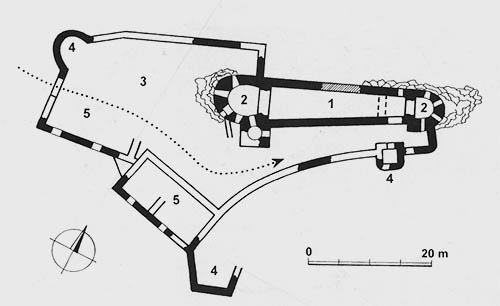The ruins of the castle are located on the low limestone back of Plešovice, which separates the Gaderská valley from the Turčianska kotlina basin, about 2 km from the village of Blatnica
The masonry of the western tower has been preserved, which still rises to a great height even today and has slotted loopholes. The upper castle is clamped between two towers. On the farm buildings in the lower castle, the challenging blocking is completely preserved and the remnants of the walls of these buildings provide a truly spectacular view.The castle consisted of a long, relatively narrow palace, strengthened on the north and south sides by semicircular towers, protected on the northeast side by a steep abyss. The western tower, built in a more vulnerable place, is much more massive and larger than the eastern one. It was made accessible by a separate spiral staircase, built on its southern side. On the southeast, more accessible side, a small courtyard was enclosed by walls with a quadrilateral tower. The wall of fortifications that surrounded the first courtyard had an entrance over a ditch cut into the rock in the west. It was protected by an open round bastion.

- 1-palace
- 2-Gothic tower rebuilt into a cannon bastion
- 3-fortification
- 4-fortification
- 5-residential and farm buildings fortification
Blatnica Castle on a steep hill behind the village of the same name was built in the second half of the 13th century and we have the first report about it from 1300, when it was owned by Peter of Brezovice. The castle was built mainly to protect the road called magna via, leading from Nitra to the north. When the more comfortable road from Nitra via Mošovce to Martin and further north began to be used, the old road under the name antiqua via lost its original meaning and the importance of the castle declined. Therefore, the rulers were not more interested in it. They often put it in advance, but the holders often only managed and used it rather than maintained it. In 1321 the castle was occupied by the royal troops of Karol Robert. At that time, Master Donč, who was one of the important nobles, also played an important role in the history of Blatnica. In addition to Blatnica, he participated, for example, in the construction of Liptovský Hrádok and Likava. He owned many other castles in our territory. After 1389, King Sigismund donated the castle to the nobleman Pogány Domonkos. Soon, however, he took the castle back and put it in deposit with Ladislav Oppelni. In 1415, after Ladislav's death, the castle belonged to his grandchildren, the princes of Glogau. From 1421 until his death (1433) the owner of the castle was Peter Berzeviczy. From 1434, Queen Borbála Cillei (Barbora Celjská) became the owner of the castle, but she soon gave the castle in advance to Pongrác of Liptovský Mikuláš for 2,300 gold coins. Pongrác handed over the castle to Ladislav Necpalský for 9,000 gold coins, and later the castle fell into the hands of Štefan Pongrácz.
The darkest period of history for Blatnica Castle meant the years 1450-1470, when Peter Komorowsky ruled the castle. He was of Polish origin and came to our territory thanks to the Hussites. In 1462 he received pardon from the king, but in 1471 he joined the dissatisfied, conspiratorial Hungarian nobility, who longed for the throne, called the Polish prince Casimir to the country. However, their plan did not work out, as in 1474 Matej Korvín's royal troops intervened and occupied all his fortresses. Komorowsky then retreated to Orava, where he again received mercy from the noble king. Ferdinand of Habsburg and in 1540 the Révay family became the owners of the castle. In the second half of the 16th and at the beginning of the 17th century, they built a large fortification with new buildings. However, they did not emphasize cannon bastions, so in 1606 the castle was simply seized without a fight by the insurgents Štefan Bocskaya and later by the army of Gabriel Bethlen. In 1678 a fire broke out and several castle buildings burned down. This was probably caused by raids by chickens led by Imrich Thököly. Shortly afterwards, the Révay family reached the castle again and restored the castle. At the end of 1703, the Kuruk rebel troops of František Rákóczi occupied the castle without any problems. A few years later, however, in 1708, after the defeated battle of Trenčín, they were forced to leave the castle. The castle returned to the hands of the Révay family.
After the uprising subsided, the importance of Blatnica Castle declined. As the Révay proved their allegiance to the Habsburgs during the Kuruk fighting, Blatnica Castle was spared an order to destroy it, which concerned excess, unused fortresses. They could still live in the castle after 1711, although many members of the family had already moved to more comfortable mansions. In 1744, Jozef Révay had the castle walls repaired, but in 1790 the last of the Révay family moved out. Since then, the castle was no longer inhabited and was slowly abandoned.
Since 2008, the Diadem - Blatnica Castle Rescue Association has been operating at the castle, performing cleaning and reconstruction work.
The legend of the castle
The cruel lord of the castle seized the bride of another, and she took off his clothes, did not hesitate to kill her and had his son walled up. He also poisoned his second wife. To this day, hear a child crying in the walls of the castle and you may meet the ghosts of murdered women.
The rumour says
Only ruins remain from Blatnica Castle. The historian Michael Bombardius also wrote in 1718 about the fact that the lords of the castle were lords of the castle in the 13th century. As the castle was rebuilt several times, nothing was preserved after the powerful Templars. Except that according to one legend, they walled up a monk in the castle. They walled him alive and locked his mouth with a lock. And the fact? Treasure hunters accidentally found a masonry male skeleton with a padlock on the left jaw in the castle ruins...
Blatoň - savior of Pribina and Mojmír
The legends about the famous Blatnický castle mention the brave young man Blatoň, who saved two lives at once, and not one of them. These were the famous princes of Nitra, Pribina and Mojmír. The gentlemen went hunting and since they also lived under the Plešovice ridge, they longed for their trophy. The female tour, who had a cub, was hit with a spear, but inaccurately. Seriously injured and enraged animals rushed at both celebrities. The bold Blatoň did not hesitate and killed him with a dagger. He took care not only of the safety of prominent hunters, but also of his future. Although he rejected Pribin's lucrative offer to be the head of his guards, he accepted a gift - a beautiful sword and building land for the future castle. Apparently according to him, the castle was named Blatnica and the area was named Turiec in honor of the memorable hunting on the Turs. Thanks to King Matej Korvín, the Kráľovská studňa locality was also given its name. It is said that the king got rid of the desperate whip of the bear that ate his sheep. Thanks to Bača, Bača invited the king to lunch in the pit, the opening for the future well, because a strong wind was blowing outside. Matej Korvín liked the picnic in the pit, he liked the Bačov specialties. Since then, it's called the Royal Well there.
The ruins are freely accessible
